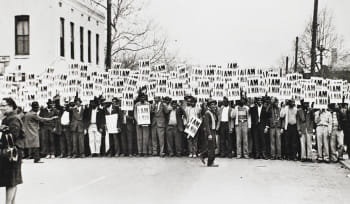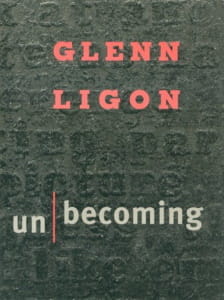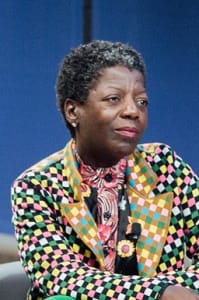Summary of Glenn Ligon
With his unique "text paintings" referencing Black thought and literature, Glenn Ligon came to prominence in the early 1990s and became known as one of the most astute observers and commentators on race, sexuality, and history in America. Tackling the representation of Blackness in art - as well as what it means to be Black and gay - Ligon's works possess an elegance and beauty underneath which lurk America's history of slavery and its ongoing racial reckoning. His art provides an example of an artistic practice that constantly interrogates Black subjectivity without sacrificing the multiplicity of viewpoints and intersectional understanding of identity.
Accomplishments
- Ligon came up with a new visual language through his text paintings, which depict a text repetitively as it gets progressively darker until the point of illegibility. The quotations selected by Ligon, most of them by major Black authors, are pithy and compelling, as well as sometimes ambiguous when taken out of context, inviting speculation about their speaker's identity and experience.
- Furthering the debates on the representation of Black bodies in art, Ligon used text and image juxtaposition to comment on Black masculinity and brought into the open a blind spot of Black Liberation and Afrocentrism discourse: the existence (and oppression) of Black homosexuality.
- In using text and injecting it with racial and historical dimensions, Ligon opened up new facets of Conceptual Art, which had been seen by many as the domain of white artists and inadequate in tackling identity issues. In so doing, his art also examines the idea of "America" in ways that resonate deeply with contemporary audiences and the renewed discussion around racial injustice.
The Life of Glenn Ligon

Being an outsider has shaped Ligon's artistic practice in several ways: as a Black person from a working-class background in the New York art world; as a Black, gay man measuring himself up against the idea of Black masculinity; as a young, Black artist looking at queer art by established white ones. Ligon turned these experiences into his art and critique of society. "You have to be a bit outside of something to see it," he stated, "I think any artist does that. It's an artist's job to always have their antennas up."
Important Art by Glenn Ligon
Untitled (I Am A Man)
This iconic work by Ligon was based on photographs taken by Ernest C. Withers documenting the 1968 sanitation workers' strike in Memphis. Prompted by the deaths of two fellow workers due to faulty equipment, 1,300 African-American workers took part in the strike, demanding fair wages and safe working conditions. The ubiquitous signs held by the workers proclaimed, "I am a man," asserting their dignity and humanity. (The text itself is a modification of Ralph Ellison's first sentence in the classic Invisible Man: "I am an invisible man.")
Zooming in on the sign, Ligon modified the layout, stretching them out into three lines (as opposed to two in the original). He also added more space between them and elongated the dimensions. The effect makes this work, standing at 101.6 cm tall, read almost like a portrait. Instead of a figure, however, we read a proclamation, the underlining of "am" by Ligon emphasizing the point, but leading one also to wonder about the need to assert it in the first place. Who or what prompted such a proclamation and why? The source photograph points to a history of racism and oppression against Black workers--and African-Americans more generally. It had been taken amidst racial tensions and the Civil Rights Movement. Martin Luther King Jr., in fact, had traveled to Memphis to support the workers. He addressed them on April 3, 1968. The following day he was assassinated.
By drawing out only the text from the historical photograph, however, Ligon also leaves open how the viewer would interpret the work (especially if we didn't know about the 1968 source). Indeed, in today's context, read "man" as a generic noun and it invites discussion on the gender dynamics behind such an assertion. Read it as a proclamation of masculinity and we may also wonder about the context of such an utterance. With knowledge that the artist is a Black gay man, for example, the sentence gains another meaning: an assertion of his masculine identity in a culture that viewed homosexuality as a deviancy from Black maleness. Ligon would address the issue of being Black and gay more explicitly in later works.
Oil and enamel on canvas - National Gallery of Art, Washington, DC.
Notes on the Margin of the Black Book
In 1986, the photographer Robert Mapplethorpe published what has now become one of his most controversial works, The Black Book, which the photographer, who was white and gay, saw as a formalist celebration of beauty in Black male physique. The book came under attack from all sides. From the right it was seen as another example of decadent identity politics art (this one especially offensive since it featured nudity and homoerotic Black male bodies). From the left, Mapplethorpe's white gaze was seen to fetishize Black bodies, stripping the models of their agency and leaving their bodies as objects for the consumption of mostly white art world viewers.
As a young Black and gay artist who was finding his way in the 1980s New York art world, the Mapplethorpe work stayed with Ligon. In Notes on the Margin of the Black Book, Ligon displayed the older artist's photographs on a wall and juxtaposed them with commentaries from a variety of sources and across the political spectrum. The work invited a reassessment of Mapplethorpe's work and a larger discussion around the representation of Black bodies in art in the early 1990s. Some who opposed Mapplethrope's original treatment critiqued Ligon for "re-validating" the images. Ligon, however, saw the public exhibition of the photographs - previously accessible to viewers only in book form - as a way of opening up debates to a wider public than specialist audiences. The commentaries alongside the photographs help to situate the works within a critical discourse. As art critic Jason Farago puts it: "It was a measured but devastating critique, from one gay artist to another, that showed no photograph of a nude Black man can escape questions of power and politics." The work addresses Ligon's identity as both Black and gay. It can also be seen as a testament to his perspective from the outside looking in, assessing the success of an older gay artist, whose whiteness arguably had afforded him room to make explicitly gay art, be a provocateur, and embraced by the art world.
91 offset prints, 78 text pages - The Solomon R. Guggenheim Museum, New York
Untitled: Four Etchings
The texts in Untitled: Four Etchings establish an ironic relationship with the form of the work, the top two panels reading: "I do not always feel colored" as the print used the color black to make the text appear. In the lower two panels, the text reads: "I am an invisible man. No, I am not a spook like those who haunted Edgar Allan Poe; nor am I one of your Hollywood-movie ectoplasms." The bare visibility of the text in gray against a black background forces the viewer to squint to see the text at all. The first quote comes from Zora Neale Hurston's 1928 essay, "How It Feels To Be Colored Me," while the latter comes from Ralph Ellison's Invisible Man (1952). The Hurston essay framed race as a social construction, long before any theorization of race in critical theory. Ligon's way of rendering the text, he said, "makes the words cast shadows, bleed into one another, [so that] their meanings seem less fixed," much like the unfixity of race as a category.
Although using text may seem diametrically opposed to the works of the Abstract Expressionist that he had admired, Ligon credited Pollock, de Kooning, and others for showing the possibility of the all-over composition: "While on first glance it would seem that the content of my work takes me far away from the concerns of those artists, the formal structure of my paintings is indebted to them." In the use of repetition including the variations of the stenciled smudges and accumulation of pigment, there's also a Warholian influence. The accidental ink spills in Warhol's silkscreening process had added variety (and sometimes ominous) visual interest to his works. In Ligon the smudges marked the difficulty of constructing and seeing a subjectivity that had been both shaped and obscured by mainstream, white-dominated culture and historical accounts.
Although text-based, Ligon's works can be understood to deal with Black bodies and their representation. In this way, the use of text may be likened to 1980s works by feminist artists such as Mary Kelly, who had turned to text as a way to deny the possible scopophilic gaze on any kind of visual representation of a female body. Ligon's text works arose partly out of this 1980s moment of artistic investigations into language, signs, and power influenced by feminist critique. The affinity with feminist interrogation of language highlights the ways in which language serves as a powerful tool to determine--but also to critique--identity and visibility (or lack thereof) in the world.
Four softground etching, aquatint, spit bite and sugarlifts on paper - The Broad
To Disembark
At first glance To Disembark seems like a Minimalist installation of objects spread out on the gallery floor. Instead of sculptural cubes, however, the work consists of nine transport crates labeled fragile, leading the viewer to wonder what they may contain. From the different crates the viewers also hear songs playing, including Billie Holiday's "Strange Fruit" (1939), a song about lynching, and the rapper KRS-One's "Sound of Da Police (1993), which addresses police brutality and racism. The song choice establishes a connection between America's slavery past and police brutality against African Americans in contemporary context. To Disembark, Ligon said, "was a way to sort of bring the notion of slavery into the present." (Its title was inspired by a book of poetry by the African American poet Gwendolyn Brooks).
The idea behind this work came from Narrative of Henry Box Brown who escaped from Slavery Enclosed in a Box 3 Feet Long and 2 Wide, which recounted the story of Henry "Box" Brown a slave in a tobacco factory in Richmond, VA, who, with the help of a sympathetic white carpenter, had put himself in a shipping crate to be sent to an anti-slavery society in Philadelphia. As the story goes, the first thing that Brown did when he came out of his crate and realized his freedom was to sing. Ligon said that he "became fascinated with the idea of this box as the container for the body, but also the idea that if he had spoken, it would have been the thing that would have given him away." The contained silence was all the more poignant given that music had been and remains so central to African-American culture (it is also another key yet often overlooked contribution of Black culture to mainstream US cultural history). Ligon's "singing" crates, which also included the sound of a heartbeat and a spiritual (religious folk song sung by African-American slaves), provided a bittersweet soundtrack of Black life in America.
Surrounding the crates, on the walls were Ligon's set of prints titled Runaways, on which he mimicked the look and language of mid-19th century fugitive slave posters but instead used his friends' descriptions of him as the text. One, for example, reads: "Ran Away, Glenn Ligon. He's a shortish broad-shouldered Black man, pretty dark-skinned with glasses [...]." The image on top shows a white man in a top hat grabbing the shoulder of a shackled Black man.
Installation
A Feast of Scraps
The title of this work refers to Ligon's interest in things that we throw away, including pornographic materials. He went to the bookshop Gay Treasures in Greenwich Village in New York (now defunct), where he found "boxes and boxes of images that chronicle our histories and desires. A feast of scraps." He was particularly taken by a box labeled "Black Men" containing photographs of male nudes from the 1970s, many of the same anonymous model. Looking at the images, however, he started to feel a sense of familiarity, as if they were "portraits of long-dead relatives you never met but in whose faces you can trace the contours of your own." That recognition led Ligon to remember: "The seventies was the decade when I discovered I was sexually attracted to men."
In A Feast of Scraps, Ligon juxtaposed the photographs from Gay Treasures with found family album photographs (including some of his own), capturing people fully clothed, in different stages of respectable, heteronormative middle-class life. Within the disjunction between the two types of images, however, lay Ligon's desire. He remembered looking at his family photos, which showed him with his cousins, "but they do not record my desire for [them]." The connection came to him going through the photographs at Gay Treasure: "The photos of Black men in Gay Treasures are the photos left out of my family albums, and when I look at them I see my cousins' faces and bodies and I remember my desire."
In the first instance, then, A Feast of Scraps brings attention to the stereotypical representation of the Black male body in the dominant pornographic imaginary. As Ligon wrote, "Pornographic images of Black men usually fall into a narrow range of types: Black men as closer to nature, sexually aggressive, enormously endowed. Black men as phallus." Beyond that, however, it also examines the cultural ideal of middle-class, nuclear family life - and the subsequent silencing of queer sexuality: "The photo album is where the family represents itself to itself, and I wanted to think about the family album as [a] site of certain silences around queer identities." Indeed within the Black Liberation movement and Afrocentrism of the 1970s, Black homosexuality was castigated. This was also the cultural context in which Ligon came of age.
The question of "the Black family" in the popular and political imagination in America, furthermore, represents another layer of meaning, as art historian Lauren DeLand argues, for the family photos here don't show the typical (white) family in America, but a Black one. The idea of a Black family had been constantly surveilled, questioned, and problematized by period cultural and academic conversations, whether through the trope of the absent father or the fear of Black women's power and independence (especially as head of a household). The Black family photo album, therefore, performs more than its white counterpart: it compensates for the negative stereotyping of Black families in culture-at-large. It is all the more important, then, that undesirable elements, such as same-sex desires, be banished from their pages, even as Ligon's recollection of them lingers between them.
Text and portfolio
Malcolm X (Version 1) #1
The familiar face of Malcolm X is colored as if with makeup: magenta lipstick, two red dots on his cheeks, with blue eye shadows. His head is covered in white paint that also erases part of its outline. This rather playful, if not irreverent, rendering of Malcolm X is part of Ligon's Coloring Books series. He had given Black-themed coloring books from the 1970s to children ages 3-9 to color as they saw fit. The resulting images became the basis for his works, including the color choice and the (at times) unruly application of paint.
Ligon was interested in the Black Liberation politics of the coloring books, a subject not taken up anymore by contemporary coloring books. "How we process history from one generation to the next," as he put it, has always been a key question motivating Ligon's works. Malcolm X, he noted, was once considered the most dangerous man in America, but now his face appears on US postage stamps. Ligon recalled being "terrified" when he first saw what the children had done to the image of Malcolm X but then realized that "images are there to be made and remade." The "disconnect" between the historical importance of the image and children's approaches to it gives a strange, compelling power to the image.
There are several versions of this work based on different children's interpretations. In this version, the uncolored, negative space of his skin may be read as a commentary on the default "white" of the paper, but perhaps also the possibility of seeing through or beyond color. Given Ligon's sustained exploration of race as a social construction, the empty space of the skin opens up the possibility, as well, of filling it in differently, more freely, even, like how a child might.
Vinyl-based paint, silkscreen ink, and gesso on canvas
Double America 2
Ligon's sign of America is doubled, the one on top upright, the other one inverted below. This work is part of a series of neon works illuminating the text "America" in different variations, including with the light switched off, flickering, or with some of the letters reversed. All in all they suggest a complex, changing picture of the idea of "America," a historical beacon of freedom and democracy which, as Ligon is well aware, was never as simple as such. The two Americas alluded to by the work may speak to different versions of life in America, one for white, the other for Black subjects, separated by systemic racism and structural barriers that impede quality of life, access to healthcare and education, as well as life expectancy, among others. The luminosity of the work is literally blocked by the black paint that Ligon applied on top of the neon, resulting in a sharp outline of the text that looks to be hovering above light and shadows. The lines trace an ideal that was never fulfilled; what it's supposed to contain remains elusive underneath, immaterial. Ligon has spoken of American democracy carrying with it "tremendous promise but also a tremendous amount of things wrong, things that need to be fixed, to be worked on"
The doubling in this work may also speak to the concept of "double consciousness" of Black subjects discussed by the sociologist and writer W.E.B Du Bois (whose writing Ligon has quoted in other works). The idea refers to "the sense of always looking at oneself through the eyes of others" and measuring oneself by the lopsided standards of a racist society: something that Ligon, as a Black artist, would've personally encountered. In the art world, different standards and expectations of works produced by white and non-white artists was and remain a continuing topic of discussion.
The two Americas may also be read in terms of politics: the polarizing political divide of the past decades, as well as in terms of class (which more often than not intersects with race): the Americas of the haves and have-nots.
Neon and paint - The Broad
Biography of Glenn Ligon
Childhood
Glenn Ligon was born to working-class parents in the Bronx in 1960. His father was a line foreman for General Motors, his mother a nurse's aide. On a scholarship he attended The Walden School in Manhattan, a progressive private school. An artistic career was never a natural path, however. "My mother used to say that when I told her that I wanted to be an artist, her famous line was, 'The only artists I've ever heard of are dead,'" Ligon said, "It just wasn't in her experience ... I don't think she had a sense that one could be an artist, because there wasn't anyone in my family who had done that." Still, because of his early interest in art, his mother enrolled him in after-school art and pottery classes at the Metropolitan Museum of Art, among other places in the city. He was also encouraged to read from a young age. "We didn't have a lot of extra money, but there was an attitude that if it was educational, it was O.K. Books, yes. Trips to the Met, yes. Hundred-dollar sneakers, no," Ligon recalled. He became an avid reader. His love of literature and language - its power, but also its ambiguity - would become formative for his artworks.
Early Training and Work

After high school, he enrolled first at the Rhode Island School of Design, where he spent two years, before transferring to Wesleyan University in Connecticut, where he graduated in 1982. He started college wanting to become an architect but then realized that he "was more interested in how people live in buildings rather than making them." He shifted to art instead, especially painting. After graduation, he made his living as a proofreader for a law firm in New York while painting on the side. His early works followed the Abstract Expressionist style of Willem de Kooning and Jackson Pollock. "When I first started making art, painting was one of the few spaces in my life where I felt free," he reflected. Looking at de Kooning's works taught him how to paint, he said, but working in an expressionist style soon proved inadequate: "I had a crisis of sorts," he recounted, "when I realized there was too much of a gap between what I wanted to say and the means I had to say it with." In 1985, he participated in the Independent Study Program at the Whitney Museum of American Art, an influential hotbed of critical theory and examination of language and power through art (where painting took a backseat). The experience provided a backdrop against his turn towards new forms and engagement with politics. The works of artists who had examined signs and their meanings in American culture, such as Jasper Johns, too, was important in this regard.

His first text-based work (and to this day one of his most iconic) was I Am A Man (1988), which was inspired by the sign held by African-American sanitation workers during a strike in Memphis in 1968, as captured in the powerful photographs by Ernest Withers. The work spoke to questions of race and identity in America that he would continue to explore throughout his career. From then Ligon experimented with different ways of using text in his paintings before arriving at a format for which he is now most identified: repetitive text that gets so smudged and layered until it becomes illegible, even abstract. Ligon first achieved this look by using oil stick on a stencil template. The residue of the oil stick would start to accumulate on the stencil, creating increasing smudges and shadow effects as he painted. He would later mimic this signature style in other mediums such as in etching. This way of using text, he said, represented a grappling with loss: "the implications of being descendant from a people whose beginnings in this country involved the systematic stripping away of everything that was familiar." One of the first works in the series referenced the writing of the African-American writer and anthropologist Zora Neale Hurston: "I feel most colored when I am thrown against a sharp white background." He adapted the text from Hurston's 1928 essay, "How It Feels to Be Colored Me," which commented on Black subjectivity in America. Quotations such as this one, Ligon reflected, "are meaningful in that they talk about the idea of race as a concept that is structured by context rather than by essence." He would continue to explore race as a construction in many of his later works.
In 1989 Ligon had his first solo show, also called "How It Feels to Be Colored Me," which consisted of his text-based works. The show put him on the map as an up-and-coming artist to watch who dealt with the difficult question of Black identity and representation. In the same year, Ligon received a grant from the National Endowment for the Arts. This was a breakthrough moment for him as an artist. It gave him the confidence boost to start making art full-time.
Mature Period

Ligon came to prominence in the early 1990s along with peers who also tackled issues of race through language in their works, such as Renée Green, Marlon Riggs, Gary Simmons, and Lorna Simpson, with whom he also developed a friendship. In 1993, for the Whitney Biennial which has now become informally known as the "identity" biennial, Ligon showed another landmark piece, Notes on the Margins of the Black Book. The work represented a new direction in his art, with the incorporation of photographs alongside the use of texts. Examining Robert Mapplethorpe's photographs of Black male nudes, it also brought into discussion another aspect of identity: the intersection of race and sexuality, reflecting his identity as a Black gay man. In the same year, he collaborated with Byron Kim, a Korean-American artist, who's also a close friend (they both had a breakout moment at the 1993 Whitney Biennial). The work, Black & White (1993) came from their shared frustration at the limited range of "flesh-colored" paint on the market, which didn't include the skin tones of their friends and family members. In a typical Minimalist-inspired style that Kim's known for, Kim painted 16 rectangular canvases using the colors available in art stores, one for each, while next to them, Ligon contributed 16 canvases of black pigments. The stark contrast between the uniformity of the black on the left side and the different hues of "flesh" on the right highlights racial prejudices that have material effects on the kinds of artworks artists can (or cannot) make.
Throughout the 1990s, Ligon's works continued to explore intersecting facets of identity, as well as the haunting presence of American slavery. From paintings and photographs, he branched out into prints and installations. In 1998 he had his first major museum exhibition, "Glenn Ligon: Unbecoming," at the Institute of Contemporary Art, Philadelphia, which cemented his reputation as a leading voice in contemporary art.
In 2006, Ligon turned to neon art. The first works played on variations of the text "America," such as by doubling and inverting it. The series had its beginning in the oft-quoted opening line of Charles Dickens's A Tale of Two Cities: "It was the best of times, it was the worst of times." Instead of repeating it like in previous text paintings, however, Ligon reflected on the meaning of the line and saw the parallel between Dickens's description of England and contemporary America: the reality of different American experiences as determined by race, class, and social disparity, thus the decision to use just the word "America." The use of neon echoes modern advertising as well as precedents in contemporary art such as the works of Dan Flavin and Bruce Nauman. But if Flavin's use of neon had been more formalist and Nauman's more ironic, Ligon used it to jolt the viewer's attention and confront them with the darker edges and history of the word depicted.
Deceptively simple yet impactful, Ligon's works have the ability to reach beyond the art world and take part in national conversation. In 2009 President Obama installed Ligon's Black Like Me, No. 2 (1992) in his private living quarters in the White House (the work was on loan from the Hirshhorn collection). The text on this painting reads: "All traces of the Griffin I had been were wiped from existence," quoting from John Howard Griffin's 1961 memoir Black Like Me, which chronicled his experience traveling through the South passing as Black by darkening his skin color. Like other text-based works, the text repeats and becomes denser and denser until it dissolves into black, an apt metaphor in this case for Griffin's experience of losing his white privileges as he "became" Black.
In 2011, Ligon had a mid-career retrospective, "Glenn Ligon: America," which opened at the Whitney Museum of American Art before traveling nationally. He has since also taken on curatorial roles as an invited artist, bringing together artworks and sometimes juxtaposing them with his as a way to further contextualize and comment on race in America, as well as to explore his artistic influences. These include shows at the New Museum in New York and Tate Liverpool in the UK. In 2021 Ligon was elected a member of the American Academy of Arts and Letters.
The Legacy of Glenn Ligon
For the art critic Robert Storr: "Glenn is someone who has figured out how to give Conceptualism some grit." Unlike the more neutral investigation of language and meaning by Conceptual art predecessors such as Joseph Kosuth, Ligon's use of text and image together highlights the more explicitly social and political dimensions of language. At the same time, his continually evolving practice and embrace of multiple mediums and sources serve as a model of an artist who can't be pigeonholed, even as politics remained a throughline: "He's influenced a younger generation, perhaps because he is a political artist but not a protest artist. He has an unwillingness to be boxed in," Storr wrote.

Ligon is credited, along with the curator Thelma Golden, for the term "post-Black," which has entered the lexicon of the contemporary art world. Golden and Ligon developed a close friendship through the 1990s with many a late-night phone conversation about everything from the going-ons of the art world to structural racism (nowadays they regularly take part in public conversations and panels together). In coming up with the term "post-Black," they were referring to "artists who were adamant about not being labeled 'Black' artists, though their work was steeped, in fact deeply interested, in redefining complex notions of Blackness." The term does not mean, as is sometimes mistakenly assumed, that race or Blackness are in the past and no longer relevant. Rather, it highlights the complex navigation of artmaking and identity by contemporary artists, especially in today's context, where, as Ligon noted, Black artists have gained more visibility in art institutions than ever, even while "identity politics" as such has come under criticism in academic and art circles. At the same time, certain expectations and stereotypes around "Black art" also still remain. As Byron Kim puts it: "[Ligon's work] is all about how we don't get to represent ourselves as precisely as we want to. We always get lost in the translation. We're always at the mercy of people's interpretations."
Ligon's works contribute to the contemporary discourse on Black representation in art. His works remind us that images of Black bodies, especially Black men, can still have something to say, including to Black subjects, despite the suspicion that they have historically only been objects of the white fetishizing gaze. To throw such images out, Ligon writes, "is not only to deny the ambivalence with which we look at the images but to deny the lives of the men depicted." Instead, Ligon shows how, with a nuanced and informed approach, "we can still use the images, inhabit and change them, read against their intended meanings, critique ourselves with them, place our stories alongside them, use them to talk about our histories and desires."
Ligon's works don't only address race and sexuality in America, but the idea of America itself, as Scott Rothkopf, who curated his retrospective at the Whitney, argued. "Although he emerged amidst a generation of artists who deal with race and sexual identity, his work speaks more broadly," Rothkopf commented, "not just to African-Americans or gay Americans, but to all Americans." Indeed, not despite of but because of his trenchant observation of racial history and dynamic in society, Ligon's work presents a clear-eyed analysis of his nation's past and present. Echoing the writer Toni Morrison's observation that Blackness has been used in the construction of Americanness by other groups (as a limit against which the ideal is imagined), Ligon states, "Exploring Blackness as a subject matter tells you about what it means to be anything else in this country."
Influences and Connections

-
![David Hammons]() David Hammons
David Hammons -
![Felix Gonzalez-Torres]() Felix Gonzalez-Torres
Felix Gonzalez-Torres -
![Kerry James Marshall]() Kerry James Marshall
Kerry James Marshall - Zoe Leonard
-
![Abstract Expressionism]() Abstract Expressionism
Abstract Expressionism -
![Neo-Dada]() Neo-Dada
Neo-Dada -
![Pop Art]() Pop Art
Pop Art -
![Conceptual Art]() Conceptual Art
Conceptual Art ![Appropriation Art]() Appropriation Art
Appropriation Art
-
![Kara Walker]() Kara Walker
Kara Walker - T.J. Dedeaux-Norris
- Daniel Joseph Martinez
- Jacolby Satterwhite
- Tschabalala Self
-
![Lorna Simpson]() Lorna Simpson
Lorna Simpson - Renée Green
- Marlon Riggs
- Gary Simmons
- Byron Kim
-
![Identity Art and Identity Politics]() Identity Art and Identity Politics
Identity Art and Identity Politics -
![Postmodernism]() Postmodernism
Postmodernism - Post-Black Art
Useful Resources on Glenn Ligon
- Yourself in the World: Selected Writings and InterviewsBy Glenn Ligon
- Glenn Ligon: Encounters and CollisionsBy Glenn Ligon
 Ask The Art Story AI
Ask The Art Story AI
























